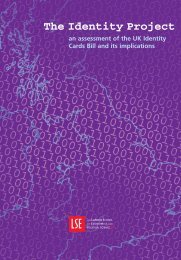Money Laundering: Review of the Reporting ... - Dematerialised ID
Money Laundering: Review of the Reporting ... - Dematerialised ID
Money Laundering: Review of the Reporting ... - Dematerialised ID
Create successful ePaper yourself
Turn your PDF publications into a flip-book with our unique Google optimized e-Paper software.
kpmg<br />
<strong>Review</strong> <strong>of</strong> <strong>the</strong> regime for handling Suspicious Activity Reports<br />
Report <strong>of</strong> recommendations<br />
KPMG LLP<br />
4.3.2 There are a number <strong>of</strong> reasons for this increase: <strong>the</strong> impact <strong>of</strong> <strong>the</strong> events <strong>of</strong> 11 September<br />
2001; <strong>the</strong> publicity from <strong>the</strong> Abacha affair; <strong>the</strong> advent <strong>of</strong> N2 and <strong>the</strong> explicit FSA<br />
regulatory focus on money laundering arising from its statutory objectives; and <strong>the</strong> impact<br />
and implementation <strong>of</strong> <strong>the</strong> initial sections <strong>of</strong> PoCA.<br />
4.3.3 These factors are likely to continue to apply, while any expansion <strong>of</strong> <strong>the</strong> FSA current<br />
customer review to regulated entities o<strong>the</strong>r than <strong>the</strong> “Big Six” banks is also likely to give<br />
rise to additional disclosures. The full introduction <strong>of</strong> Part 7 <strong>of</strong> PoCA 10 on 24 February<br />
2003 will also add to <strong>the</strong> level <strong>of</strong> disclosures that are made. The financial sector industry<br />
estimates in <strong>the</strong>ir response to our survey that on average PoCA will lead to a 14%<br />
increase in <strong>the</strong> number <strong>of</strong> money laundering SARs submitted to ECB, although <strong>the</strong><br />
figures are considerably higher in <strong>the</strong> larger retail banks that provide <strong>the</strong> greatest number<br />
<strong>of</strong> SARs. This alone is <strong>the</strong>refore likely to push <strong>the</strong> total number <strong>of</strong> SARs to at least<br />
100,000 in 2003, regardless <strong>of</strong> <strong>the</strong> impact <strong>of</strong> any o<strong>the</strong>r factors, for example <strong>the</strong> impact <strong>of</strong><br />
<strong>the</strong> increase in fraud disclosures expected under <strong>the</strong> new legislation.<br />
Over-reporting<br />
“There is more defensive reporting now due to <strong>the</strong> FSA”<br />
“The danger is that we are being pushed into frightened compliance. The FSA are more<br />
worried about missing something ... than supporting NCIS”<br />
“MLROs are getting scared as <strong>the</strong>y are being faced with punishments <strong>of</strong> 12 to 14 years if<br />
<strong>the</strong>y do not do <strong>the</strong>ir job properly. To be brutally honest, <strong>the</strong> implications <strong>of</strong> overregulating<br />
are that NCIS will have received reports which it should not have received”<br />
“I didn’t like his attitude” (as a reason for disclosing)<br />
Source: Interviewees and questionnaire respondents as part <strong>of</strong> KPMG’s review<br />
4.3.4 MLROs are faced with a challenge in <strong>the</strong>ir decisions on whe<strong>the</strong>r or not to disclose a<br />
suspicion to ECB. The MLRO is presented with potentially suspicious transactions or<br />
activities by staff within a firm and/or by specialist computer systems. The MLRO must<br />
decide which <strong>of</strong> <strong>the</strong>se to report to ECB. There is, however, no definition <strong>of</strong> “suspicion”<br />
despite <strong>the</strong> availability <strong>of</strong> <strong>the</strong> JMLSG Guidance Notes. This is not an exact science and is<br />
not black and white. If <strong>the</strong> MLRO errs on <strong>the</strong> side <strong>of</strong> caution and reports more activities,<br />
or has a lower threshold <strong>of</strong> suspicion, this is very difficult to identify, or indeed criticise.<br />
4.3.5 A number <strong>of</strong> <strong>the</strong> disclosing entities we interviewed stated that <strong>the</strong>re has been overreporting<br />
<strong>of</strong> SARs since N2. This has in part accounted for <strong>the</strong> growth in numbers <strong>of</strong><br />
disclosures over <strong>the</strong> last two years. It appears that <strong>the</strong>re are a number <strong>of</strong> disclosures<br />
which have been made by regulated entities that are effectively “defensive reports”.<br />
4.3.6 There is also an evident lack <strong>of</strong> knowledge <strong>of</strong> <strong>the</strong> law and <strong>the</strong> JMLSG Guidance Notes<br />
among a number <strong>of</strong> those who are potentially required to report suspicious transactions;<br />
this can, for example, lead to over-reporting based on a (mis)perception that all<br />
transactions over a given size must be reported, ra<strong>the</strong>r than those which are assessed to be<br />
suspicious. Bureaux de change, for example, tend to report all transactions over a<br />
9 Source: ECB<br />
10 i.e. <strong>the</strong> part that deals with money laundering<br />
jo/fh/519 34









